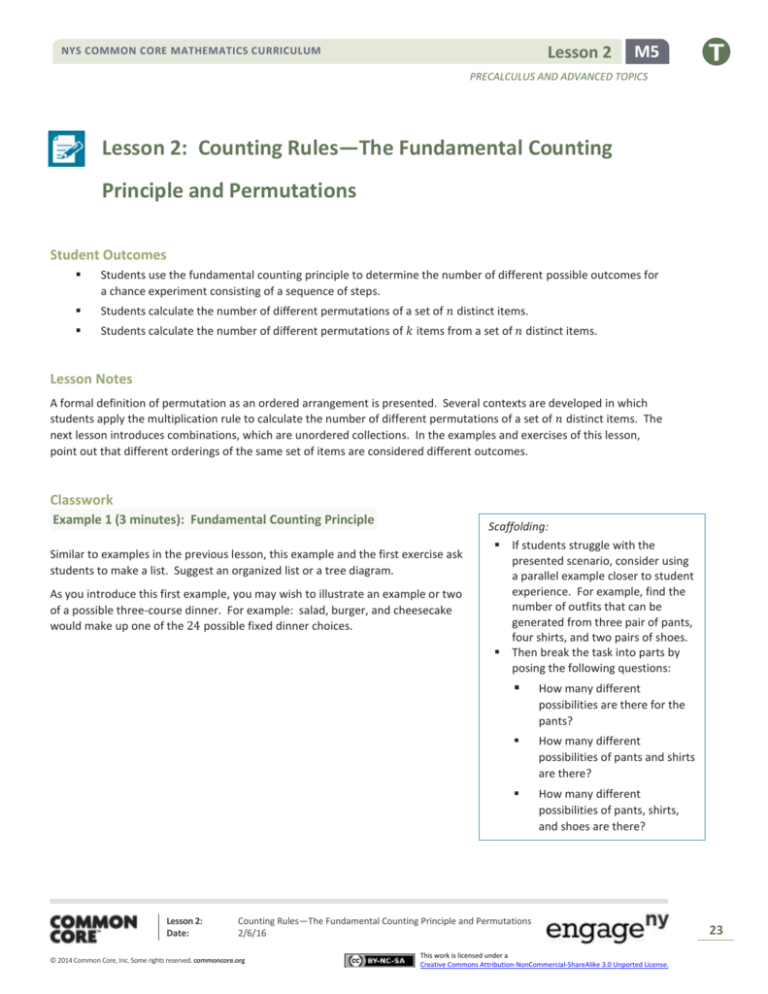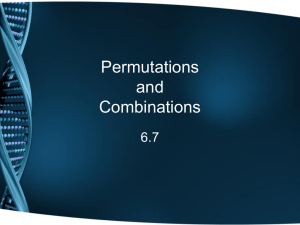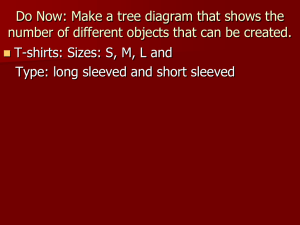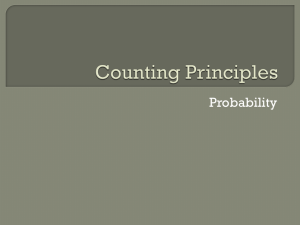
Lesson 2
NYS COMMON CORE MATHEMATICS CURRICULUM
M5
PRECALCULUS AND ADVANCED TOPICS
Lesson 2: Counting Rules—The Fundamental Counting
Principle and Permutations
Student Outcomes
Students use the fundamental counting principle to determine the number of different possible outcomes for
a chance experiment consisting of a sequence of steps.
Students calculate the number of different permutations of a set of 𝑛 distinct items.
Students calculate the number of different permutations of 𝑘 items from a set of 𝑛 distinct items.
Lesson Notes
A formal definition of permutation as an ordered arrangement is presented. Several contexts are developed in which
students apply the multiplication rule to calculate the number of different permutations of a set of 𝑛 distinct items. The
next lesson introduces combinations, which are unordered collections. In the examples and exercises of this lesson,
point out that different orderings of the same set of items are considered different outcomes.
Classwork
Example 1 (3 minutes): Fundamental Counting Principle
Scaffolding:
Similar to examples in the previous lesson, this example and the first exercise ask
students to make a list. Suggest an organized list or a tree diagram.
As you introduce this first example, you may wish to illustrate an example or two
of a possible three-course dinner. For example: salad, burger, and cheesecake
would make up one of the 24 possible fixed dinner choices.
Lesson 2:
Date:
If students struggle with the
presented scenario, consider using
a parallel example closer to student
experience. For example, find the
number of outfits that can be
generated from three pair of pants,
four shirts, and two pairs of shoes.
Then break the task into parts by
posing the following questions:
How many different
possibilities are there for the
pants?
How many different
possibilities of pants and shirts
are there?
How many different
possibilities of pants, shirts,
and shoes are there?
Counting Rules—The Fundamental Counting Principle and Permutations
2/6/16
© 2014 Common Core, Inc. Some rights reserved. commoncore.org
This work is licensed under a
Creative Commons Attribution-NonCommercial-ShareAlike 3.0 Unported License.
23
Lesson 2
NYS COMMON CORE MATHEMATICS CURRICULUM
M5
PRECALCULUS AND ADVANCED TOPICS
Example 1: Fundamental Counting Principle
A restaurant offers a fixed-price dinner menu for $𝟑𝟎. The dinner consists of three courses, and the diner chooses one
item for each course.
The menu is shown below:
First Course
Second Course
Third Course
Salad
Burger
Cheesecake
Tomato Soup
Grilled Shrimp
Ice Cream Sundae
French Onion Soup
Mushroom Risotto
Ravioli
Exercises 1–4 (12 minutes)
Students should work in small groups (2 or 3 students per group). Allow about 5 minutes for them to complete Exercise
1; then, discuss as a class the strategies that groups used to list all the possibilities. Ask students to explain how they
know that they have listed all the possibilities and compare/critique the methods that are shared. Then pose the
MP.3 following question to the class. Allow about 5 minutes for discussion and possible
Scaffolding:
presentation of additional examples as needed.
If students struggle to
In general, how can you find the number of possibilities in situations like this?
articulate the principle,
consider presenting additional
I found that the number of possibilities is the same as the product of the
examples and then asking
choices for each course (or clothing option). So in general, I can multiply
them again to generalize the
the number of choices that each option can occur.
rule:
Convey to students that this generalization is known as the fundamental counting
You are ordering lunch. The
principle. Instead of making a list or a tree diagram, another method for finding the total
only choice for an entrée is a
number of possibilities is to use the fundamental counting principle. Suppose that a
hamburger. You need to
process involves a sequence of steps or events. Let 𝑛1 be the number of ways the first
choose chips or fries. The
step or event can occur and 𝑛2 be the number of ways the second step or event can
drink options are bottled
water, lemonade, or apple
occur. Continuing in this way, let 𝑛𝑘 be the number of ways the 𝑘th stage or event can
juice. Find the number of
occur. Then the total number of different ways the process can occur is:
possibilities for your lunch.
𝑛1 ∙ 𝑛2 ∙ 𝑛3 ∙ … ∙ 𝑛𝑘 .
You are planning activities for
In the fixed-price dinner example, there are 3 choices for the first course (step 1), 4
the weekend. On Saturday you
choices for the second course (step 2), and 2 choices for the third course (step 3). Using
can either go to the movies or
the fundamental counting principle, there are 3 ∙ 4 ∙ 2, or 24 total choices. For the fixedto the mall. On Sunday you
dinner example, the students could draw three boxes and label the boxes as shown. Then,
can choose to participate in
identify the number of choices for each box.
one of the following sports
events: basketball, soccer, flag
First Course Second Course Third Course
football, or lacrosse. Find the
(3 choices)
(4 choices)
(2 choices)
number of possibilities for
weekend activities.
Students can continue working in small groups to complete Exercises 2–4. Confirm answers as a class.
Lesson 2:
Date:
Counting Rules—The Fundamental Counting Principle and Permutations
2/6/16
© 2014 Common Core, Inc. Some rights reserved. commoncore.org
This work is licensed under a
Creative Commons Attribution-NonCommercial-ShareAlike 3.0 Unported License.
24
Lesson 2
NYS COMMON CORE MATHEMATICS CURRICULUM
M5
PRECALCULUS AND ADVANCED TOPICS
Exercises 1–4
1.
Make a list of all of the different dinner fixed-price meals that are possible. How many different meals are possible?
Note: The list below shows all the possibilities using abbreviations of the items.
They are listed in order, first course choice, second course choice, and third course choice. For example, SBC would
represent salad, burger, and cheesecake.
There are 𝟐𝟒 different dinner fixed-price meals possible.
SBC
TBC
FBC
SBI
TBI
FBI
SGC
TGC
FGC
SGI
TGI
FGI
SMC
TMC
FMC
SMI
TMI
FMI
SRC
TRC
FRC
SRI
TRI
FRI
B
G
S
M
R
B
G
T
M
R
B
G
F
M
R
2.
C
I
C
I
C
I
C
I
C
I
C
I
C
I
C
I
C
I
C
I
C
I
C
I
For many computer tablets, the owner can set a 𝟒-digit pass code to lock the device.
a.
How many digits could you choose from for the first number of the pass code?
𝟏𝟎
Lesson 2:
Date:
Counting Rules—The Fundamental Counting Principle and Permutations
2/6/16
© 2014 Common Core, Inc. Some rights reserved. commoncore.org
This work is licensed under a
Creative Commons Attribution-NonCommercial-ShareAlike 3.0 Unported License.
25
Lesson 2
NYS COMMON CORE MATHEMATICS CURRICULUM
M5
PRECALCULUS AND ADVANCED TOPICS
b.
How many digits could you choose from for the second number of the pass code? Assume that the numbers
can be repeated.
𝟏𝟎
c.
How many different 𝟒-digit pass codes are possible? Explain how you got your answer.
𝟏𝟎 ∙ 𝟏𝟎 ∙ 𝟏𝟎 ∙ 𝟏𝟎 = 𝟏𝟎, 𝟎𝟎𝟎
There are 𝟏𝟎 choices for the first digit, 𝟏𝟎 choices for the second digit, 𝟏𝟎 choices for the third digit, and 𝟏𝟎
choices for the fourth digit. I used the fundamental counting principle and multiplied the number of choices
for each digit together to get the number of possible pass codes.
d.
How long (in hours) would it take someone to try every possible code if it takes three seconds to enter each
possible code?
𝟏
𝟑
Scaffolding:
It would take 𝟑𝟎, 𝟎𝟎𝟎 seconds, which is 𝟖 hr.
3.
The store at your school wants to stock sweatshirts that come in four sizes (small, medium,
large, xlarge) and in two colors (red and white). How many different types of sweatshirts
will the store have to stock?
𝟒∙𝟐 = 𝟖
The call letters for all radio stations in the United States start with either a 𝑾 (east of the
Mississippi river) or a 𝑲 (west of the Mississippi River) followed by three other letters that
can be repeated. How many different call letters are possible?
4.
𝟐 ∙ 𝟐𝟔 ∙ 𝟐𝟔 ∙ 𝟐𝟔 = 𝟑𝟓, 𝟏𝟓𝟐
The word stock has
multiple meanings and
may confuse English
language learners.
Point out that in this
context, stock refers to a
supply of goods or items
kept on hand for sale to
customers by a merchant.
Consider displaying an
image of clothing on store
shelves to reinforce the
meaning of the word.
Example 2 (3 minutes): Permutations
This example introduces the definition of permutations. Combinations will be introduced in the next lesson, so the focus
of this example is that the order matters for a permutation. The permutation formula is not introduced until Example 3.
Give students a moment to read through the example, and ask them to share ideas among their group for how to
determine the number of pass codes.
If students struggle, break the task into parts by posing the following questions:
How many digits can you choose from for the first digit? 10
How many digits can you choose from for the second digit? (Remember–no repeats) 9
How many digits can you choose from for the third digit? 8
How many digits can you choose from for the fourth digit? 7
Encourage students to write out the number choices in the diagram, show the multiplication, and make the connection
to the fundamental counting principle.
How many different 4-digit pass codes are possible if digits cannot be repeated?
10 ∙ 9 ∙ 8 ∙ 7 = 5,040
Lesson 2:
Date:
Counting Rules—The Fundamental Counting Principle and Permutations
2/6/16
© 2014 Common Core, Inc. Some rights reserved. commoncore.org
This work is licensed under a
Creative Commons Attribution-NonCommercial-ShareAlike 3.0 Unported License.
26
Lesson 2
NYS COMMON CORE MATHEMATICS CURRICULUM
M5
PRECALCULUS AND ADVANCED TOPICS
Explain how the fundamental counting principle allows you to make this calculation.
The process of choosing the four digits for the pass code involves a sequence of events. There are 10
choices for the first digit, 9 choices for the second digit, and so on. So, I can multiply the number of
choices that each digit in the pass code can occur.
Now introduce the notation for permutations. Explain that finding the number of ordered arrangements of the digits in
the pass code is an example of the number of permutations of 10 things taken 4 at a time. This can be written: 10𝑃4 =
10 ∙ 9 ∙ 8 ∙ 7 = 5,040.
Example 2: Permutations
Suppose that the 𝟒-digit pass code a computer tablet owner uses to lock the device cannot have any digits that repeat.
For example, 𝟏𝟐𝟑𝟒 is a valid pass code. However, 𝟏𝟏𝟐𝟑 is not a valid pass code since the digit “𝟏” is repeated.
An arrangement of four digits with no repeats is an example of a permutation. A permutation is an arrangement in a
certain order (a sequence).
How many different 𝟒-digit pass codes are possible if digits cannot be repeated?
1st digit
2nd digit
3rd digit
4th digit
Exercises 5–9 (8 minutes)
Students should work in small groups (2 or 3 students per group). Allow about 8 minutes for them to complete Exercises
5–9. Encourage students to write the permutation notation and to write out the multiplication. At this point, students
should use a calculator to perform the multiplication rather than using the permutation option on the calculator.
Point out to students that when they simplify this formula, the result is the same as using the fundamental counting
principle when numbers cannot be repeated. For example: If a password requires three distinct letters, how many
different passwords are possible? Students could solve as 26 ∙ 25 ∙ 24.
When students have finished answering the questions, discuss the answers.
Exercises 5–9
5.
Suppose a password requires three distinct letters. Find the number of permutations for the three letters in the
code, if the letters may not be repeated.
𝟐𝟔𝑷𝟑
6.
= 𝟐𝟔 ∙ 𝟐𝟓 ∙ 𝟐𝟒 = 𝟏𝟓, 𝟔𝟎𝟎
The high school track has 𝟖 lanes. In the 𝟏𝟎𝟎 meter dash, there is a runner in each lane. Find the number of ways
that 𝟑 out of the 𝟖 runners can finish first, second, and third.
𝟖𝑷𝟑
= 𝟖 ∙ 𝟕 ∙ 𝟔 = 𝟑𝟑𝟔
Lesson 2:
Date:
Counting Rules—The Fundamental Counting Principle and Permutations
2/6/16
© 2014 Common Core, Inc. Some rights reserved. commoncore.org
This work is licensed under a
Creative Commons Attribution-NonCommercial-ShareAlike 3.0 Unported License.
27
Lesson 2
NYS COMMON CORE MATHEMATICS CURRICULUM
M5
PRECALCULUS AND ADVANCED TOPICS
7.
There are 𝟏𝟐 singers auditioning for the school musical. In how many ways can the director choose first a lead
singer and then a stand-in for the lead singer?
𝟏𝟐𝑷𝟐
8.
= 𝟏𝟐 ∙ 𝟏𝟏 = 𝟏𝟑𝟐
A home security system has a pad with 𝟗 digits (𝟏 to 𝟗). Find the number of possible 𝟓-digit pass codes:
a.
if digits can be repeated.
𝟗 ∙ 𝟗 ∙ 𝟗 ∙ 𝟗 ∙ 𝟗 = 𝟓𝟗, 𝟎𝟒𝟗
b.
if digits cannot be repeated.
𝟗𝑷𝟓
9.
MP.8
= 𝟗 ∙ 𝟖 ∙ 𝟕 ∙ 𝟔 ∙ 𝟓 = 𝟏𝟓, 𝟏𝟐𝟎
Based on the patterns observed in Exercises 5–8, describe a general formula that can be used to find the number of
permutations of 𝒏 things taken 𝒓 at a time, or 𝒏 𝑷𝒓
Based on the answers to the exercises, a permutation of 𝒏 things take 𝒓 at a time can be found using the formula:
𝒏 ∙ (𝒏 − 𝟏) ∙ (𝒏 − 𝟐) ∙ … ∙ (𝒏 − 𝒓 + 𝟏).
Before moving to the next example, use the following as an opportunity to informally assess student understanding.
Explain to your neighbor how to find the number of permutations of 𝑛 things taken 𝑟 at a time.
Example 3 (5 minutes): Factorials and Permutations
Factorial notation is introduced in this example. It is also important to tell students that 0! is defined to be equal to 1
(see scaffolding note). After defining factorial notation, show students how to find factorial on their calculator. Use 9!
as an example.
Note there are a variety of calculators and software that can be used to find factorials. The steps displayed here refer to
the TI-84 graphing calculator and are meant to serve only as a quick reference for teachers:
1. Enter the integer (9) on the Home screen.
2. Select the MATH menu.
3. Scroll to PRB.
4. Select option 4: !
Lesson 2:
Date:
Counting Rules—The Fundamental Counting Principle and Permutations
2/6/16
© 2014 Common Core, Inc. Some rights reserved. commoncore.org
This work is licensed under a
Creative Commons Attribution-NonCommercial-ShareAlike 3.0 Unported License.
28
Lesson 2
NYS COMMON CORE MATHEMATICS CURRICULUM
M5
PRECALCULUS AND ADVANCED TOPICS
5. Press ENTER
Now discuss the permutation formula and show students all the steps prior to using the permutation option on the
9!
calculator. For example, 9𝑃4 = (9−4)! =
9!
5!
=
9∙8∙7∙6∙5∙4∙3∙2∙1
5∙4∙3∙2∙1
= 9 ∙ 8 ∙ 7 ∙ 6. Showing these steps reinforces the connection
to the fundamental counting principle.
Example 3: Factorials and Permutations
You have purchased a new album with 𝟏𝟐 music tracks and loaded it onto your MP3 player. You set the MP3 player to
play the 𝟏𝟐 tracks in a random order (no repeats). How many different orders could the songs be played in?
This is the permutation of 𝟏𝟐 things taken 𝟏𝟐 at a time, or
𝟏𝟐 𝑷𝟏𝟐 = 𝟏𝟐 ∙ 𝟏𝟏 ∙ 𝟏𝟎 ∙ 𝟗 ∙ 𝟖 ∙ 𝟕 ∙ 𝟔 ∙ 𝟓 ∙ 𝟒 ∙ 𝟑 ∙ 𝟐 ∙ 𝟏 = 𝟒𝟕𝟗, 𝟎𝟎𝟏, 𝟔𝟎𝟎.
The notation 𝟏𝟐! is read “𝟏𝟐 factorial” and equals 𝟏𝟐 ∙ 𝟏𝟏 ∙ 𝟏𝟎 ∙ 𝟗 ∙ 𝟖 ∙ 𝟕 ∙ 𝟔 ∙ 𝟓 ∙ 𝟒 ∙ 𝟑 ∙ 𝟐 ∙ 𝟏.
Factorials and Permutations
Scaffolding:
The factorial of a non-negative integer 𝒏 is
𝒏! = 𝒏 ∙ (𝒏 − 𝟏) ∙ (𝒏 − 𝟐) ∙ (𝒏 − 𝟑) ∙ … ∙ 𝟏.
Note: 𝟎! is defined to equal 𝟏.
The number of permutations can also be found using factorials. The number of permutations
of 𝒏 things taken 𝒓 at a time is
𝒏!
.
𝐧𝐏𝐫 =
(𝒏 − 𝒓)!
Now have students compare the general formula they described in Exercise 9 with the
permutation formula that was just introduced.
Give students an
opportunity to explain why
0! is equal to 1.
Consider using the
following to demonstrate
why 0! is equal to 1:
5! = 5 ∙ (4 ∙ 3 ∙ 2 ∙ 1) or
5! = 5 ∙ 4!
By rearranging the
5!
equation, we get 4! = ,
5
4! = 4 ∙ (3 ∙ 2 ∙ 1), or 4! =
4 ∙ 3!
By rearranging the
4!
equation, we get 3! = .
Therefore, 0! =
Lesson 2:
Date:
1!
1
4
= 1.
Counting Rules—The Fundamental Counting Principle and Permutations
2/6/16
© 2014 Common Core, Inc. Some rights reserved. commoncore.org
This work is licensed under a
Creative Commons Attribution-NonCommercial-ShareAlike 3.0 Unported License.
29
Lesson 2
NYS COMMON CORE MATHEMATICS CURRICULUM
M5
PRECALCULUS AND ADVANCED TOPICS
Rewrite the permutation formula by expanding the factorial notation.
Permutation:
𝑛𝑃𝑟
=
=
𝑛!
(𝑛 − 𝑟)!
𝑛 ∙ (𝑛 − 1) ∙ (𝑛 − 2) ∙ … ∙ (𝑛 − 𝑟 + 1) ∙ (𝑛 − 𝑟) ∙ (𝑛 − 𝑟 − 1) ∙ … ∙ 1
(𝑛 − 𝑟) ∙ (𝑛 − 𝑟 − 1) ∙ … ∙ 1
= 𝑛 ∙ (𝑛 − 1) ∙ (𝑛 − 2) ∙ … ∙ (𝑛 − 𝑟 + 1)
How does this formula compare with the general formula you described in Exercise 9?
The formulas are the same. My formula from Exercise 9 was
𝑛𝑃𝑟 = 𝑛 ∙ (𝑛 − 1) ∙ (𝑛 − 2) ∙ … ∙ (𝑛 − 𝑟 + 1).
The permutation formula is just another version of the fundamental counting principle.
Show students how to find permutations using technology. The following are steps to find 9 P4 using the permutation
option on the TI-84 graphing calculator:
1. Enter the integer (9) on the Home screen.
2. Select the MATH menu.
3. Scroll to PRB.
4. Select option 2: nPr.
5. Enter 4 and press ENTER.
Lesson 2:
Date:
Counting Rules—The Fundamental Counting Principle and Permutations
2/6/16
© 2014 Common Core, Inc. Some rights reserved. commoncore.org
This work is licensed under a
Creative Commons Attribution-NonCommercial-ShareAlike 3.0 Unported License.
30
Lesson 2
NYS COMMON CORE MATHEMATICS CURRICULUM
M5
PRECALCULUS AND ADVANCED TOPICS
Exercises 10–15 (7 minutes)
Students should work in small groups (2 or 3 students per group). Allow about 7 minutes for them to complete Exercises
MP.2 10–15. Exercise 13 requires students to reason abstractly and quantitatively as they determine how repetition affects
the number of outcomes. Encourage students to write the permutation formula and show the substitution. Some of the
3
answers require the use of scientific notation. You many need to remind students of the notation and how the
calculator displays the results. One common student error is that they do not see the 𝐸 displayed for scientific notation.
The screen shot below shows the results for 20!. Some students may record the answer as 2.43 instead of 2.43 𝑥 1018.
When students have finished answering the questions, discuss the answers.
Exercises 10–15
10. If 𝟗! is 𝟑𝟔𝟐, 𝟖𝟖𝟎, find 𝟏𝟎!.
𝟑, 𝟔𝟐𝟖, 𝟖𝟎𝟎
11. How many different ways can the 𝟏𝟔 numbered pool balls be placed in a line on the pool table?
𝟏𝟔! 𝒐𝒓 𝟏𝟔𝑷𝟏𝟔 = 𝟐 ∙ 𝟏𝟎𝟏𝟑
12. Ms. Smith keeps eight different cookbooks on a shelf in one of her kitchen cabinets. How many ways can the eight
cookbooks be arranged on the shelf?
𝟖! or 𝟖𝑷𝟖 = 𝟒𝟎, 𝟑𝟐𝟎
13. How many distinct 𝟒-letter groupings can be made with the letters from the word champion if letters may not be
repeated?
𝟖𝑷𝟒
=
𝟖!
= 𝟏, 𝟔𝟖𝟎
(𝟖 − 𝟒)!
14. There are 𝟏𝟐 different rides at an amusement park. You buy five tickets that allow you to ride on five different
rides. In how many different orders can you ride the five rides? How would your answer change if you could repeat
a ride?
Different order:
𝟏𝟐𝑷𝟑
=(
𝟏𝟐!
= 𝟗𝟓, 𝟎𝟒𝟎
𝟏𝟐−𝟓)!
Repeat rides: 𝟏𝟐𝟓 = 𝟐𝟒𝟖, 𝟖𝟑𝟐
Lesson 2:
Date:
Counting Rules—The Fundamental Counting Principle and Permutations
2/6/16
© 2014 Common Core, Inc. Some rights reserved. commoncore.org
This work is licensed under a
Creative Commons Attribution-NonCommercial-ShareAlike 3.0 Unported License.
31
Lesson 2
NYS COMMON CORE MATHEMATICS CURRICULUM
M5
PRECALCULUS AND ADVANCED TOPICS
15. In the summer Olympics, 𝟏𝟐 divers advance to the finals of the 𝟑-meter springboard diving event. How many
different ways can the divers finish 1st, 2nd, or 3rd?
𝟏𝟐𝑷𝟑
=
𝟏𝟐!
= 𝟏, 𝟑𝟐
(𝟏𝟐 − 𝟑)!
Closing (2 minutes)
How do permutations relate to the fundamental counting principle?
Sample response: Permutations are just another version of the fundamental counting principle.
Ask students to summarize the key ideas of the lesson in writing or by talking to a neighbor. Use this as an
opportunity to informally assess student understanding. The lesson summary provides some of the key ideas
from this lesson.
Lesson Summary
Let 𝒏𝟏 be the number of ways the first step or event can occur and 𝒏𝟐 be the number of ways the second
step or event can occur. Continuing in this way, let 𝒏𝒌 be the number of ways the 𝒌th stage or event can
occur. Then based on fundamental counting principle, the total number of different ways the process
can occur is: 𝒏𝟏 ∙ 𝒏𝟐 ∙ 𝒏𝟑 ∙ … ∙ 𝒏𝒌 .
The factorial of a non-negative integer 𝒏 is
𝒏! = 𝒏 ∙ (𝒏 − 𝟏) ∙ (𝒏 − 𝟐) ∙ (𝒏 − 𝟑) ∙ … ∙ 𝟏.
Note: 𝟎! is defined to equal 𝟏.
The number of permutations of 𝒏 things taken 𝒓 at a time is
𝒏𝑷𝑟
=
𝒏!
.
(𝒏 − 𝒓)!
Exit Ticket (5 minutes)
Lesson 2:
Date:
Counting Rules—The Fundamental Counting Principle and Permutations
2/6/16
© 2014 Common Core, Inc. Some rights reserved. commoncore.org
This work is licensed under a
Creative Commons Attribution-NonCommercial-ShareAlike 3.0 Unported License.
32
Lesson 2
NYS COMMON CORE MATHEMATICS CURRICULUM
M5
PRECALCULUS AND ADVANCED TOPICS
Name
Date
Lesson 2: Counting Rules—The Fundamental Counting Principle
and Permutations
Exit Ticket
1.
2.
The combination for the lock shown below consists of three numbers.
a.
If the numbers can be repeated, how many different combinations are there?
Explain your answer.
b.
If the numbers cannot be repeated, how many different combinations are
there? Explain your answer.
Jacqui is putting together sets of greeting cards for a school fundraiser. There are four different card options, two
different colored envelopes, and four different sticker designs. A greeting card set consists of one type of card, one
color for the envelopes, and one sticker design. How many different ways can Jacqui arrange the greeting card sets?
Explain how you determined your answer.
Lesson 2:
Date:
Counting Rules—The Fundamental Counting Principle and Permutations
2/6/16
© 2014 Common Core, Inc. Some rights reserved. commoncore.org
This work is licensed under a
Creative Commons Attribution-NonCommercial-ShareAlike 3.0 Unported License.
33
Lesson 2
NYS COMMON CORE MATHEMATICS CURRICULUM
M5
PRECALCULUS AND ADVANCED TOPICS
Exit Ticket Sample Solutions
1.
The combination for the lock shown below consists of three numbers.
a.
If the numbers can be repeated, how many different combinations are
there? Explain your answer.
𝟒𝟎𝟑 = 𝟔𝟒, 𝟎𝟎𝟎
Because numbers can be repeated, there are 40 choices for each of the
three digits. Therefore, I applied the fundamental counting principle.
b.
If the numbers cannot be repeated, how many different combinations
are there? Explain your answer.
𝟒𝟎𝑷𝟑
= 𝟓𝟗, 𝟐𝟖𝟎
Since numbers cannot be repeated, this is an example of a permutation.
2.
Jacqui is putting together sets of greeting cards for a school fundraiser. There are four different card options, two
different colored envelopes, and four different sticker designs. A greeting card set consists of one type of card, one
color for the envelopes, and one sticker design. How many different ways can Jacqui arrange the greeting card sets?
By using the fundamental counting principle, there are 𝟒 ∙ 𝟐 ∙ 𝟒 = 𝟑𝟐 ways to arrange the sets.
Problem Set Sample Solutions
Use this space to describe any specific details about the problem set for teacher reference.
1.
For each of the following, show the substitution in the permutation formula and find the answer.
a.
𝟒𝑷𝟒
𝟒!
𝟒∙𝟑∙𝟐∙𝟏
=
= 𝟐𝟒
(𝟒 − 𝟒)!
𝟎!
b.
𝟏𝟎𝑷𝟐
𝟏𝟎!
𝟏𝟎!
=
= 𝟏𝟎 ∙ 𝟗 = 𝟗𝟎
(𝟏𝟎 − 𝟐)!
𝟖!
c.
𝟓!
𝟓!
=
= 𝟓
(𝟓 − 𝟏)! 𝟒!
2.
A serial number for a TV begins with three letters, is followed by six numbers, and ends in one letter. How many
different serial numbers are possible? Assume the letters and numbers can be repeated.
𝟐𝟔 ∙ 𝟐𝟔 ∙ 𝟐𝟔 ∙ 𝟏𝟎 ∙ 𝟏𝟎 ∙ 𝟏𝟎 ∙ 𝟏𝟎 ∙ 𝟏𝟎 ∙ 𝟏𝟎 ∙ 𝟐𝟔 = 𝟒. 𝟔 ∙ 𝟏𝟎𝟏𝟏
Lesson 2:
Date:
Counting Rules—The Fundamental Counting Principle and Permutations
2/6/16
© 2014 Common Core, Inc. Some rights reserved. commoncore.org
This work is licensed under a
Creative Commons Attribution-NonCommercial-ShareAlike 3.0 Unported License.
34
Lesson 2
NYS COMMON CORE MATHEMATICS CURRICULUM
M5
PRECALCULUS AND ADVANCED TOPICS
3.
In a particular area code, how many phone numbers (###-####) are possible? The first digit cannot be a zero and
assume digits can be repeated.
𝟗 ∙ 𝟏𝟎 ∙ 𝟏𝟎 ∙ 𝟏𝟎 ∙ 𝟏𝟎 ∙ 𝟏𝟎 ∙ 𝟏𝟎 = 𝟗, 𝟎𝟎𝟎, 𝟎𝟎𝟎
4.
There are four NFL teams in the AFC east: Bills, Jets, Dolphins, and Patriots. How many different ways can two of
the teams finish first and second?
𝟒𝑷𝟐
5.
= 𝟏𝟐
How many ways can 𝟑 of 𝟏𝟎 students come in first, second, and third place in a spelling contest, if there are no ties?
𝟏𝟎𝑷𝟑
6.
In how many ways can a president, a treasurer, and a secretary be chosen from among nine candidates if no person
can hold more than one position?
𝟗𝑷𝟑
7.
= 𝟕𝟐𝟎
= 𝟓𝟎𝟒
How many different ways can a class of 𝟐𝟐 second graders line up to go to lunch?
𝟐𝟐! =
8.
𝟐𝟐𝑷𝟐𝟐
= 𝟏. 𝟏 ∙ 𝟏𝟎𝟐𝟏
Describe a situation that could be modeled by using 𝟓𝑷𝟐 .
Answers will vary. Suppose that there are five members of a family living at home. The first one home has to take
out the garbage, and the second one home has to walk the dog. 𝟓𝑷𝟐 can be used to model the number of ways the
family members can be assigned the different tasks.
9.
To order books from an online site, the buyer must open an account. The buyer needs a username and a password.
a.
If the username needs to be eight letters, how many different usernames are possible:
i.
if letters can be repeated?
𝟐𝟔𝟖 = 𝟐 ∙ 𝟏𝟎𝟏𝟏
ii.
if the letters cannot be repeated?
𝟐𝟔𝑷𝟖
b.
= 𝟔. 𝟑 ∙ 𝟏𝟎𝟏𝟎
If the password must be eight characters, which can be any of the 𝟐𝟔 letters, 𝟏𝟎 digits, and 𝟏𝟐 special
keyboard characters, how many passwords are possible:
i.
if characters can be repeated?
𝟒𝟖𝟖 = 𝟐. 𝟖 ∙ 𝟏𝟎𝟏𝟑
ii.
if characters cannot be repeated?
𝟒𝟖𝑷𝟖
Lesson 2:
Date:
= 𝟏. 𝟓 ∙ 𝟏𝟎𝟏𝟑
Counting Rules—The Fundamental Counting Principle and Permutations
2/6/16
© 2014 Common Core, Inc. Some rights reserved. commoncore.org
This work is licensed under a
Creative Commons Attribution-NonCommercial-ShareAlike 3.0 Unported License.
35
Lesson 2
NYS COMMON CORE MATHEMATICS CURRICULUM
M5
PRECALCULUS AND ADVANCED TOPICS
c.
How would your answers to part (b) change if the password is case-sensitive? (In other words, Password and
password are considered different because the letter p is in uppercase and lowercase.)
The answers would change because the number of letters that can be used will double to 𝟓𝟐, which means
the number of characters that can be used is now 𝟕𝟒.
So, if characters can be repeated, the answer will be
𝟕𝟐𝟖 = 𝟕. 𝟐 ∙ 𝟏𝟎𝟏𝟒 .
If characters cannot be repeated, the answer will be
𝟕𝟐𝑷𝟖
= 𝟒. 𝟖 ∙ 𝟏𝟎𝟏𝟒 .
10. Create a scenario to explain why 𝟑𝑷𝟑 = 𝟑!.
Suppose three friends are running in a race. 𝟑𝑷𝟑 can be used to model the order in which the three friends
finish in 1st, 2nd, and 3rd place. There are three choices for 1st place and two choices for 2nd place, which only
leaves one choice for 3rd place. So, there are 𝟑 ∙ 𝟐 ∙ 𝟏 = 𝟑!, or 𝟔 ways for the friends to finish the race.
11. Explain why 𝒏𝑷𝒏 = 𝒏! for all positive integers 𝒏.
Using the permutation formula:
𝒏𝑷𝒓
=
𝒏!
.
(𝒏 − 𝒓)!
In this case 𝒓 = 𝒏, therefore:
𝒏𝑷𝒏
Lesson 2:
Date:
=
𝒏!
𝒏! 𝒏!
= = = 𝒏!.
(𝒏 − 𝒏)! 𝟎! 𝟏
Counting Rules—The Fundamental Counting Principle and Permutations
2/6/16
© 2014 Common Core, Inc. Some rights reserved. commoncore.org
This work is licensed under a
Creative Commons Attribution-NonCommercial-ShareAlike 3.0 Unported License.
36










